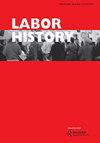Wage gap between the State and non-State sectors in China: a study from the perspective of the Housing Provident Fund Scheme
IF 0.7
4区 管理学
Q1 HISTORY
引用次数: 0
Abstract
ABSTRACT As an important component of China’s social security system, the housing provident fund (HPF) scheme has seen its fairness called into question. Based on the data from the China Household Finance Survey in 2017, this paper uses the least squares method and the unconditional quantile regression and decomposition method to study the wage gap between the state and non-state sectors from the perspective of the HPF. Its findings suggest that the HPF is an important component of the state-sector wage premium. That is, whether wages include the HPF affects the direction and significance of the sectoral wage gap. A closer look reveals that in the state sector, low-income workers benefit less from the HPF scheme than middle- and high-income workers. The breakdown of the wage gap within the state sector indicates that the wage premium for the middle- and high-income bracket and for the high-income bracket are mainly credited to the differences in individual characteristics of state-sector workers, while the wage premium obtained by the middle- and low-income bracket takes the form of the sectoral wage level, which benefits from the HPF system to some extent.中国国有和非国有部门的工资差距:基于住房公积金计划视角的研究
摘要住房公积金作为我国社会保障体系的重要组成部分,其公平性受到质疑。基于2017年中国家庭金融调查的数据,本文采用最小二乘法和无条件分位数回归分解法,从HPF的角度研究了国有和非国有部门的工资差距。研究结果表明,HPF是国有部门工资溢价的重要组成部分。也就是说,工资是否包括HPF会影响部门工资差距的方向和意义。仔细观察会发现,在国有部门,低收入工人从HPF计划中受益的人数少于中高收入工人。对国有部门内部工资差距的细分表明,中高收入阶层和高收入阶层的工资溢价主要归因于国有部门工人个人特征的差异,而中低收入阶层获得的工资溢价采取部门工资水平的形式,这在一定程度上得益于HPF系统。
本文章由计算机程序翻译,如有差异,请以英文原文为准。
求助全文
约1分钟内获得全文
求助全文
来源期刊

Labor History
Multiple-
CiteScore
1.00
自引率
28.60%
发文量
44
期刊介绍:
Labor History is the pre-eminent journal for historical scholarship on labor. It is thoroughly ecumenical in its approach and showcases the work of labor historians, industrial relations scholars, labor economists, political scientists, sociologists, social movement theorists, business scholars and all others who write about labor issues. Labor History is also committed to geographical and chronological breadth. It publishes work on labor in the US and all other areas of the world. It is concerned with questions of labor in every time period, from the eighteenth century to contemporary events. Labor History provides a forum for all labor scholars, thus helping to bind together a large but fragmented area of study. By embracing all disciplines, time frames and locales, Labor History is the flagship journal of the entire field. All research articles published in the journal have undergone rigorous peer review, based on initial editor screening and refereeing by at least two anonymous referees.
 求助内容:
求助内容: 应助结果提醒方式:
应助结果提醒方式:


